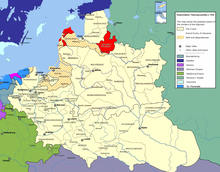Duchy of Livonia
The Duchy of Livonia ( Polish Księstwo Inflanckie or Księstwo Zadźwińskie , Latin Ducatus Ultradunensis "Duchy beyond the Daugava ") was a titular duchy from 1561/1566 to 1629/1660 and (from 1561) an administrative unit of the Grand Duchy of Lithuania and later Polish-Lithuanian condominium , part of the Republic of Poland-Lithuania .
In their title, the rulers of Poland-Lithuania claimed that they were also dukes of Livonia.
Emergence
After the Union of Vilna was concluded in 1561, large parts of the Teutonic Order in Livonia came under Lithuanian sovereignty. At the same time the spiritual possessions were secularized . The Livonian part of the Teutonic Order ceased to exist. The Duchy of Courland and Zemgale was formed from the south-western part , which under the last Landmeister Gotthard Kettler retained a relative autonomy as a vassal state .
From Riga and the areas north of the Daugava , the Duchy of Livonia was constituted as titular duchy in 1566, which after the Union of Lublin in 1569 was under the direct rule of Poland-Lithuania as a condominium of both parts of the empire. This duchy was divided into the voivodeships of Wenden , Pernau and Dorpat . The property of the Bishop of Courland , who resided in Pilten in the area of the Duke of Courland and Zemgale, was temporarily also administered from the Duchy of Livonia.
As the city of Riga opposed the Catholic Counter-Reformation , Wenden was chosen as the seat of the Bishop of Livonia.
In the war against Sweden 1621–1629 , large parts of the Duchy of Livonia were lost as Swedish Livonia to the Kingdom of Sweden . In the Second Northern War , Russian troops were able to penetrate the remaining eastern part to Riga in 1656-1658 , while Poland-Lithuania again pushed back the Swedes in the north in an offensive in 1659 and thus briefly restored the core area of the duchy around Wenden. The territorial losses of 1629 to the Swedes were finally recognized under international law in the Treaty of Oliva 1660.
After the conclusion of the Treaty of Andrussowo in 1667, the Czarism of Russia finally surrendered the eastern parts of the duchy that had been occupied during the war from 1654 to 1667 , which were administered as the Voivodeship of Livonia (in Polish Województwo inflanckie ) and are also known as Polish Livonia from the 1620s .
literature
- Gert von Pistohlkors : German history in Eastern Europe: Baltische Land Siedler Verlag, Berlin 2002. ISBN 3-88680-774-6 .
-
Otto von Rutenberg : History of the Baltic provinces Liv-, Esth- and Kurland from the earliest times to the end of their independence . Engelmann, Leipzig 1859/1860.
- Volume 1, Leipzig 1859 ( full text, Google )
- Volume 2. With a name and subject index and a map of Liv, Esth and Courland at the time of the order. Leipzig 1860 ( full text, Google )
-
Friedrich Georg von Bunge (Ed.): Liv-, Esth- and Curländisches Urkundenbuch including regesta . Kluge and Ströhm, Reval 1853–?
- Volume I: 1093-1300 , Reval 1853 ( full text, Google )
- Volume II: 1301–1367 , Reval 1855 ( full text, Google )
- Volume III
- Volume IV
- Volume V, Issue 1, Reval 1862 ( full text, Google )


